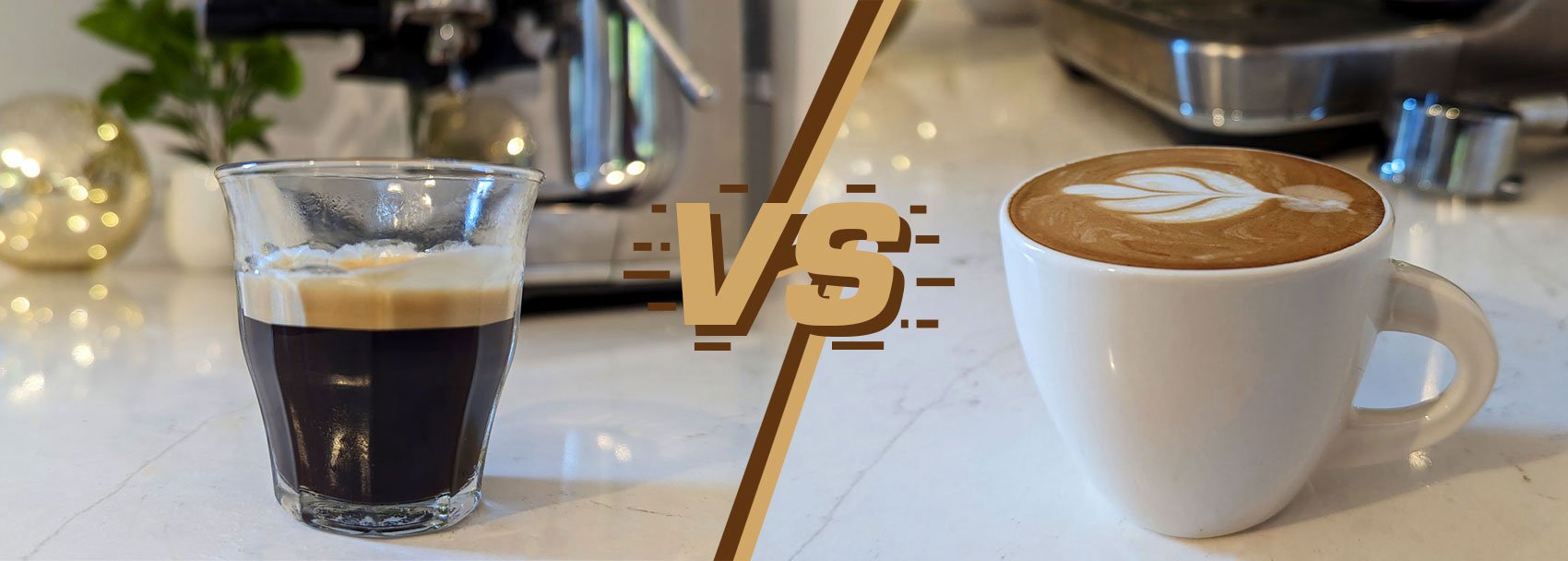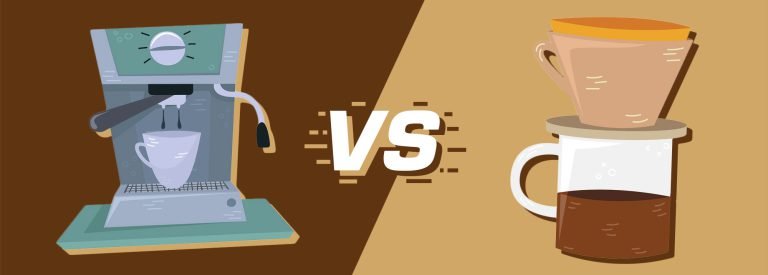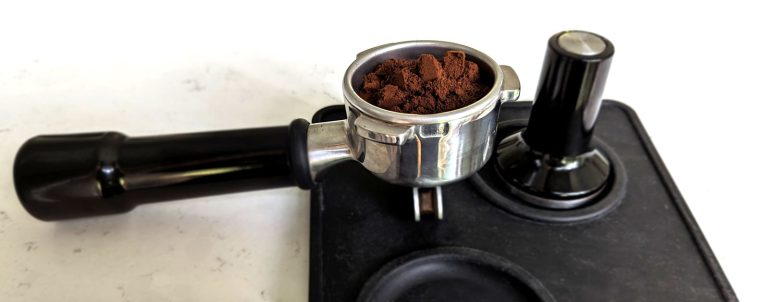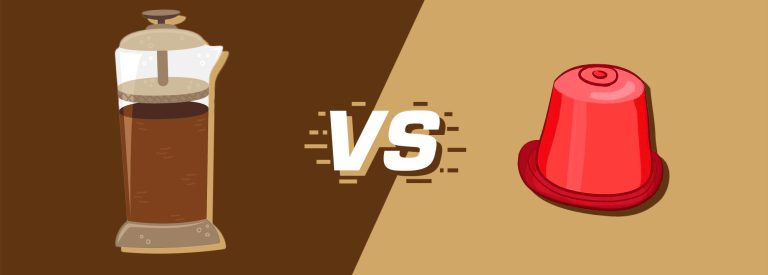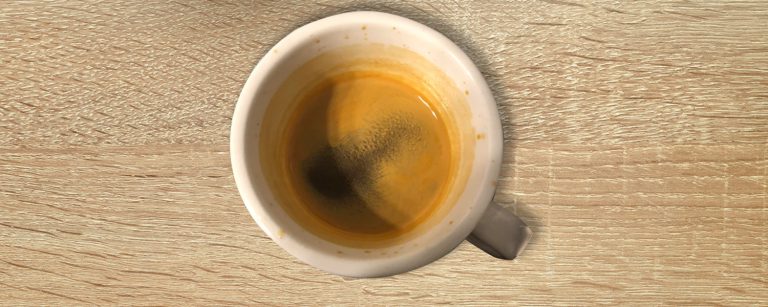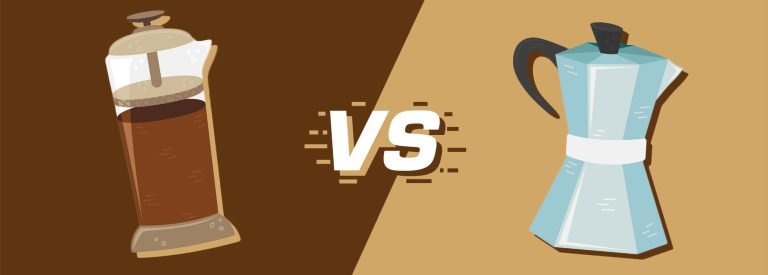Espresso vs Flat White: Two Popular Coffees Compared
Espresso and flat white are two of the most popular choices at cafés, but you may be confused about what differentiates these drinks.
Fret not. I will let you in on these drinks’ similarities, differences, ingredients, ratios, how to make them, and more.
So grab your favorite mug and let’s begin your home barista training.
What is Espresso?
The first espresso machine was patented by Italian entrepreneur Luigi Bezzera in 1901 Italy. His ambition was to offer a speedy fix of coffee, so he utilized high pressure for his brew, which unexpectedly also resulted in a distinct kind of coffee drink.

Served in a small cup known as a demitasse, which typically holds 2-3 oz (60-90 ml), a single shot of espresso has a serving size of 1 oz (30 ml) while a double shot is 2 oz (60 ml). Espresso has a coffee-to-water ratio ranging from 1:2 to 1:3, using 7g of coffee grounds for a single shot and 14g for a double shot (third-wave coffee uses 9g for a shot and 18g for a double).
I must confess, I really appreciate this rich, robust, and concentrated coffee crowned by a golden crema. Each espresso shot comes loaded with flavors when brewed right, and of course, caffeine that injects energy into me at any time of the day. Circadian rhythm? Forget about it.
Here are the steps to craft the perfect espresso:
- Weigh the coffee.
- Adjust the grind setting on your coffee grinder.
- Distribute the coffee evenly in the portafilter.
- Tamp the coffee with consistent pressure.
- Brew the espresso using a high-quality espresso machine.
- Serve immediately in a pre-warmed cup.
If you want to master the art of this famous brew, check out my detailed guide on how to make an espresso.
What is Flat White?
The flat white, hailing from Australia, offers a delicious mix of robust coffee and milk. It is made from a double espresso or double ristretto (aka a shorter espresso with a 1:1.5 brew ratio) mixed with a generous share of steamed milk, which you might swap with soy or almond milk if you prefer.
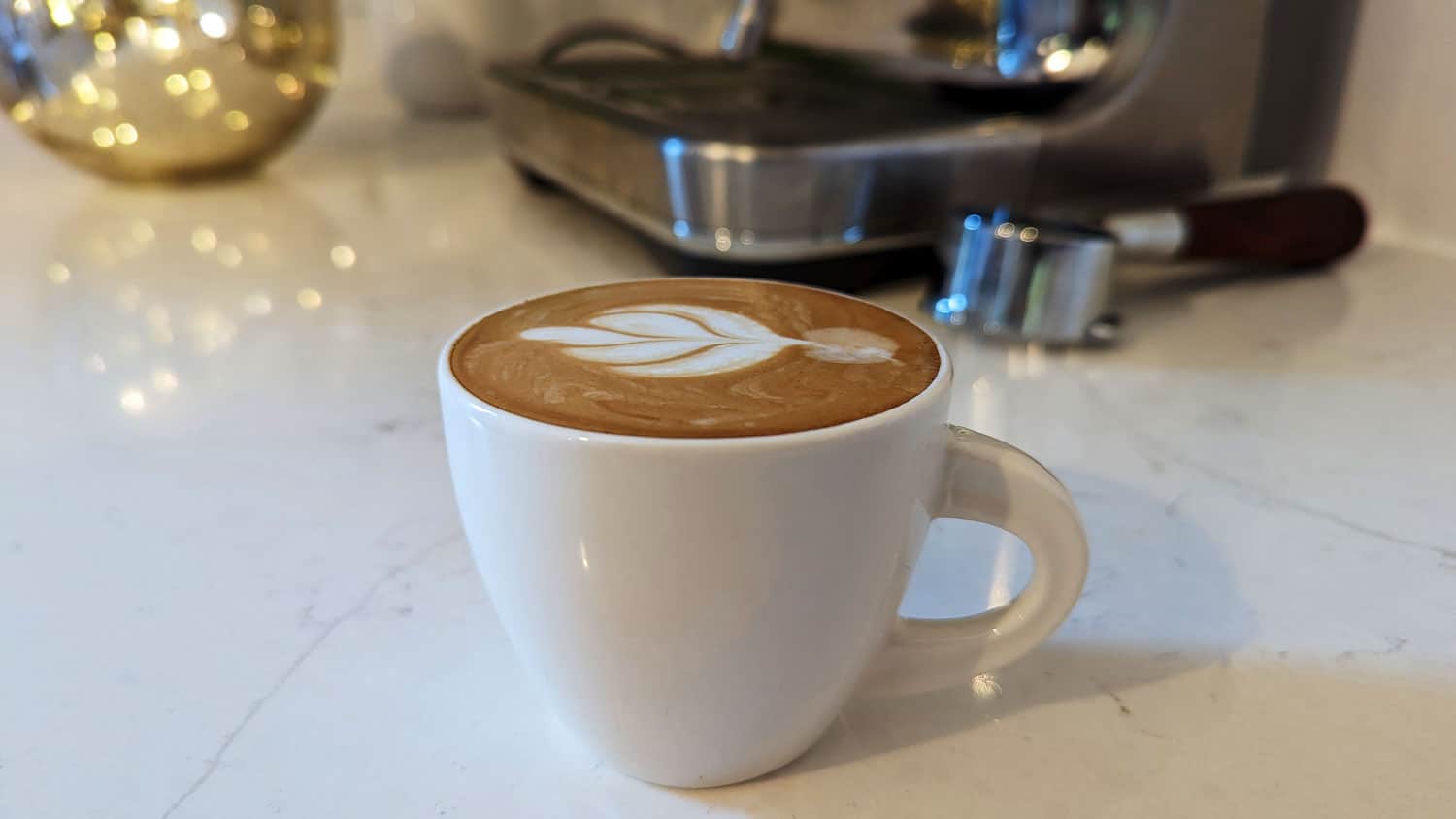
With portions varying from 5 to 6 oz (150 to 180 ml), a flat white is served in a cappuccino cup capable of holding about 6 oz (180 ml).
When you sip on a flat white, you will have a potent yet harmonious coffee experience, marked by a creamy consistency that melds seamlessly with the robust backbone of the espresso. The strength of the double espresso/ristretto is tamed by the steamed milk, reducing the sharpness of the acidity to a pleasant level.
Here’s how you can prepare a flat white at home:
- First, prepare a double espresso/ristretto.
- While the espresso is brewing, pour cold milk into a steaming pitcher. It’s best to pour just enough to reach the bottom of the spout.
- Heat and steam the milk until it reaches around 160 degrees Fahrenheit while aerating, creating a silky texture with microfoam. Here are some easy ways to make milk froth at home, but an espresso machine’s steam wand is best.
- Pour the steamed milk into the cup, mixing the coffee with the milk. If you use an espresso machine’s steaming wand, you can create latte art to decorate your coffee with a heart, a tulip, and many other intricate designs.
- Finish when your thin microfoam layer is level with the top of your cup.
To read more about crafting this delicious beverage, visit my comprehensive guide on how to make a Flat White like a barista.
Espresso & Flat White Compared: Similarities and Differences
Now that we know what the drinks are on their own, here is a quick table comparing their features.
| Aspect | Espresso | Flat White |
|---|---|---|
| Taste and Texture | Robust and concentrated flavor with a thick texture | Strong yet balanced taste with a creamy, velvety texture |
| Coffee-to-Water Ratio | 1:2 to 1:3 | Altered by the addition of steamed milk |
| Ingredient Ratio | Just coffee | Double espresso/ristretto and two parts steamed milk |
| Typical Serving Size (oz & ml) | 1 oz (30 ml) single shot, 2 oz (60 ml) double shot | 5 to 6 oz (150 to 180 ml) |
| Caffeine Content (mg) | 60-80 mg per 1 oz shot | 120-160 mg from double shot of espresso/ristretto |
| Calories | 2 calories per shot | Approx. 22 calories (18 from milk) |
| Acidity | Moderate acidity | Low to moderate acidity |
| Brewing Difficulty | Intermediate | Home barista |
Now let’s compare the espresso and flat white in detail.
- Ground coffee weight: While a traditional Italian espresso utilizes 7 grams of ground coffee to achieve a 1:2 to 1:3 coffee-to-water ratio ( third-wave espressos use 9 grams), a flat white takes it a step further by incorporating a double espresso/ristretto with two parts of steamed milk.
- Taste: The high coffee content and infusion of milk have significant effects on how flat white differs from your pure shot of espresso. An espresso, with its concentrated formula, offers a robust and intense flavor, characterized by a thick texture with a golden crema layer on top.
You then have flat white which has harmony in its fusion of the strong, yet balanced coffee taste and the creamy, velvety texture of the steamed milk. This gives the drink a smooth taste and texture. - Volume, calories, and caffeine: An espresso is served in smaller quantities, with a single shot being 1 oz (30 ml) which contains 60-80 mg of caffeine and has about 2 calories. In contrast, the added espresso shot and milk in a flat white give it a larger serving size of 5 to 6 oz (150 to 180 ml), containing 120-160 mg of caffeine and 22 calories; though you can tone down on the calories with other milk alternatives.
- Bean roast: In my experience as a barista, light to medium roasts are best for making espresso as the process preserves the coffee beans’ complex flavors and moderate acidity. Authentic Italian espresso uses dark roasts though, so all to their own I guess 🙂
When I fix flat whites though, I go for medium or dark roasts which complement the creamy texture and balanced taste profile of the final drink. You need the stronger coffee flavor in milked coffee beverages, otherwise, it just gets lost. - Steamed milk: You want your flat white to have a nice blend of steamed milk along with a thin layer of microfoam. This ultimately leads to a creamy and velvety texture that sets it apart from a traditional espresso which contains no milk nor froth.
- Serving suggestion: As for the drinking part, I enjoy my espresso alongside a glass of sparkling water as this palate-cleanser allows me to fully immerse in its flavors. When I need the extra kick but crave something on the creamy side, I opt for the flat white. Just be careful since it’s easy to overdo the caffeine with this one.
For better espresso, be sure to pick the proper coffee beans for your drink. Visit my roundup of the best coffee beans for espresso in 2024.
Conclusion
Through my experience in coffee making, I’ve found myself leaning towards the flat white, especially during calm weekend afternoons when I can just take the time to enjoy my coffee. It adds comfort to a soothing ritual, which contrasts how espresso gets me going during busy days.
How about you? Which one do you prefer?

